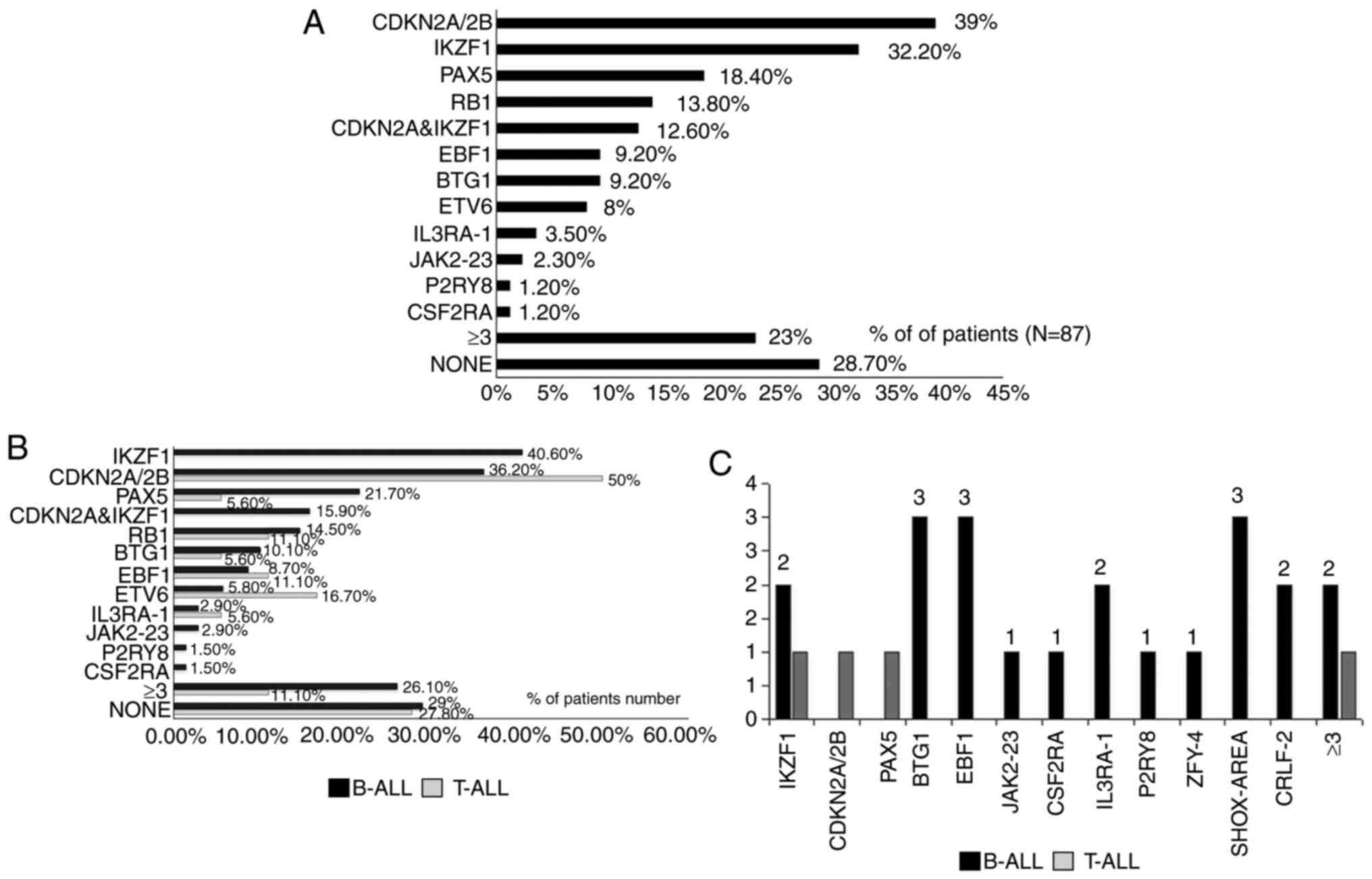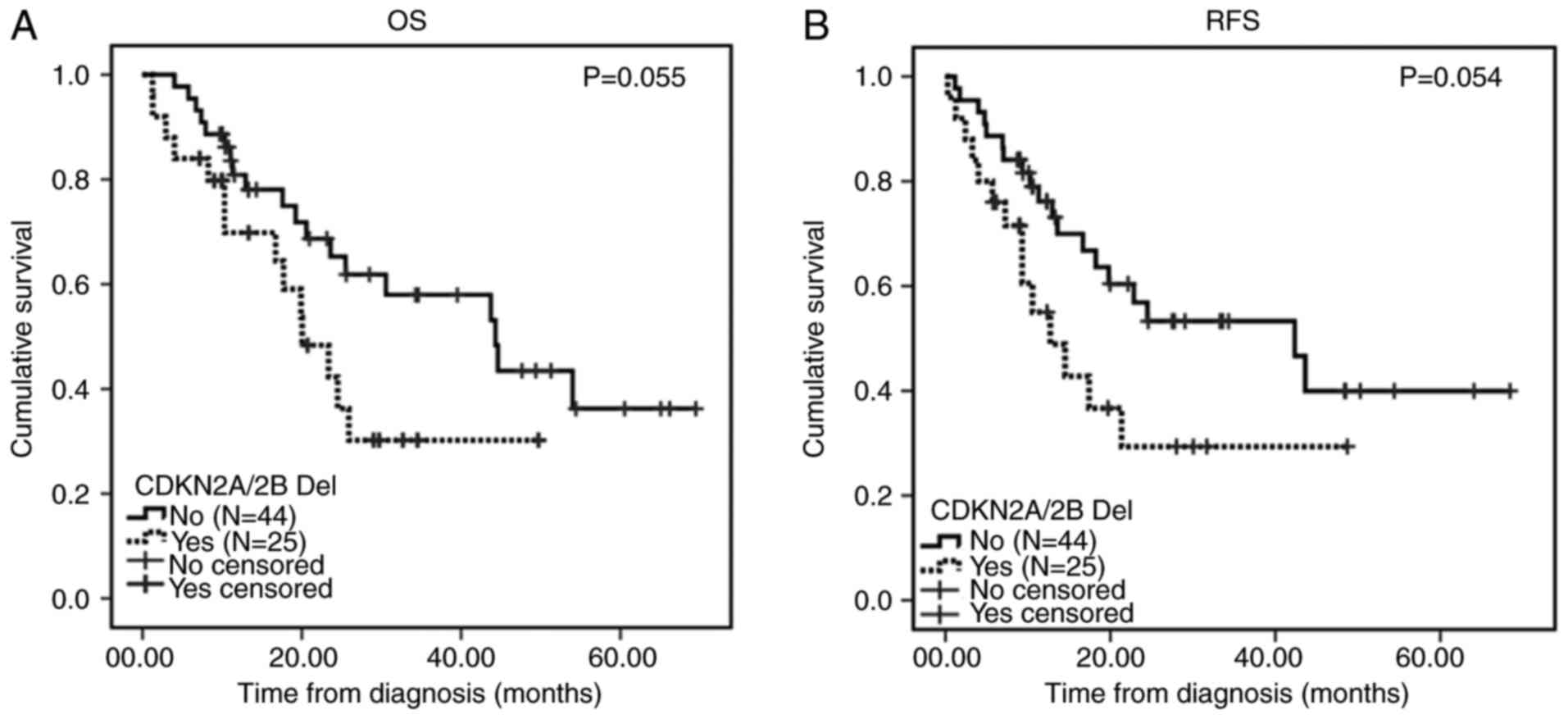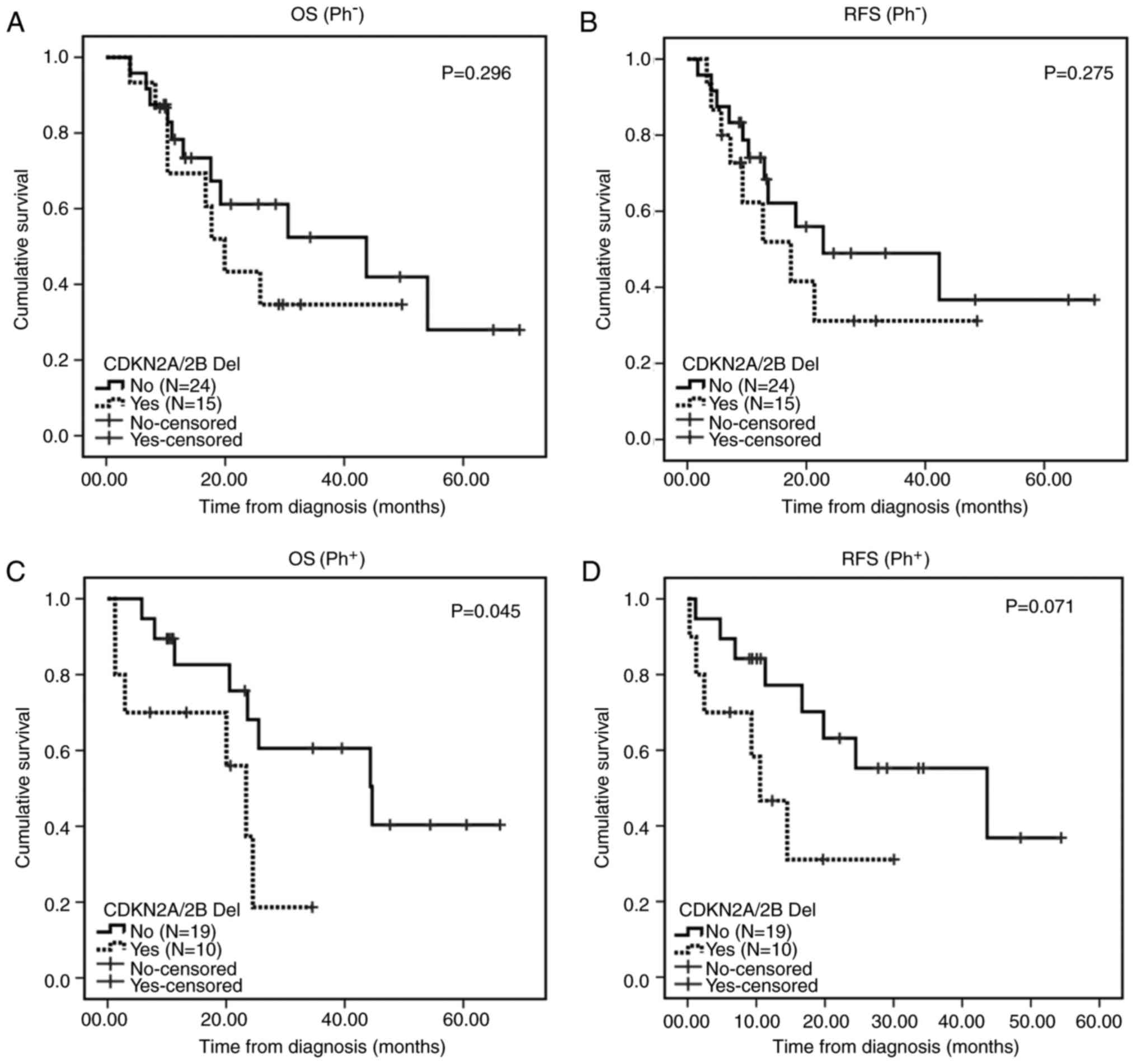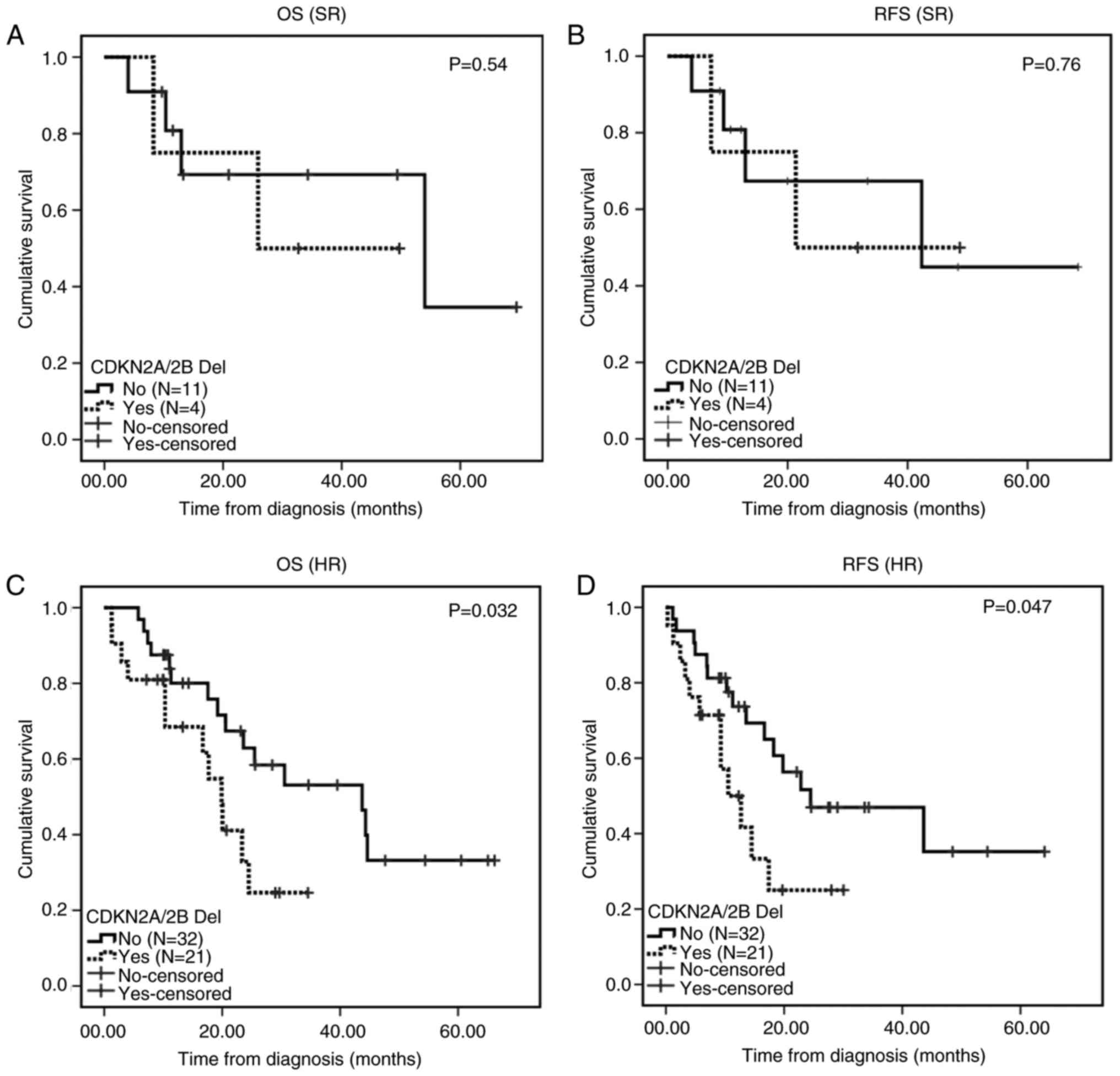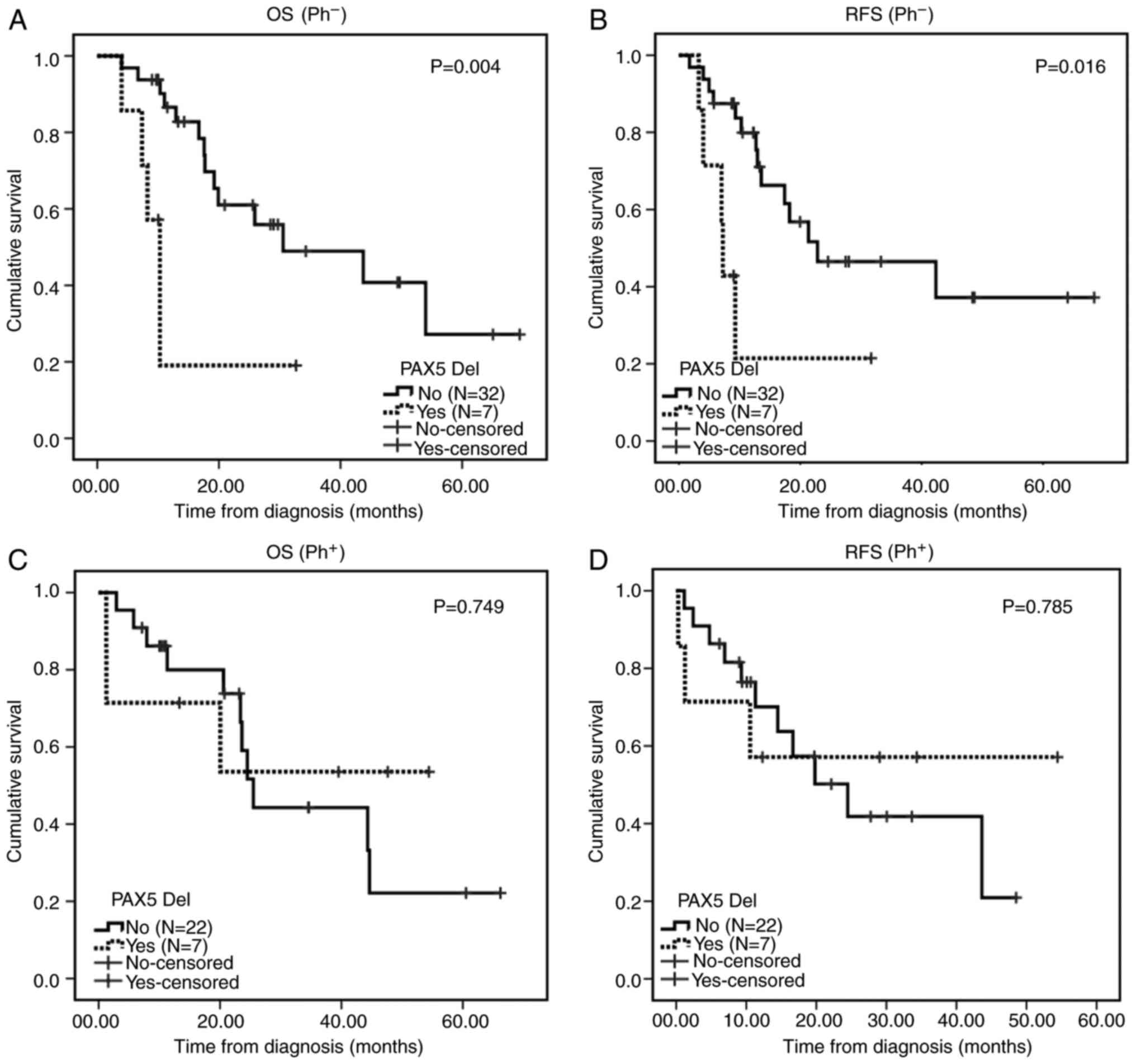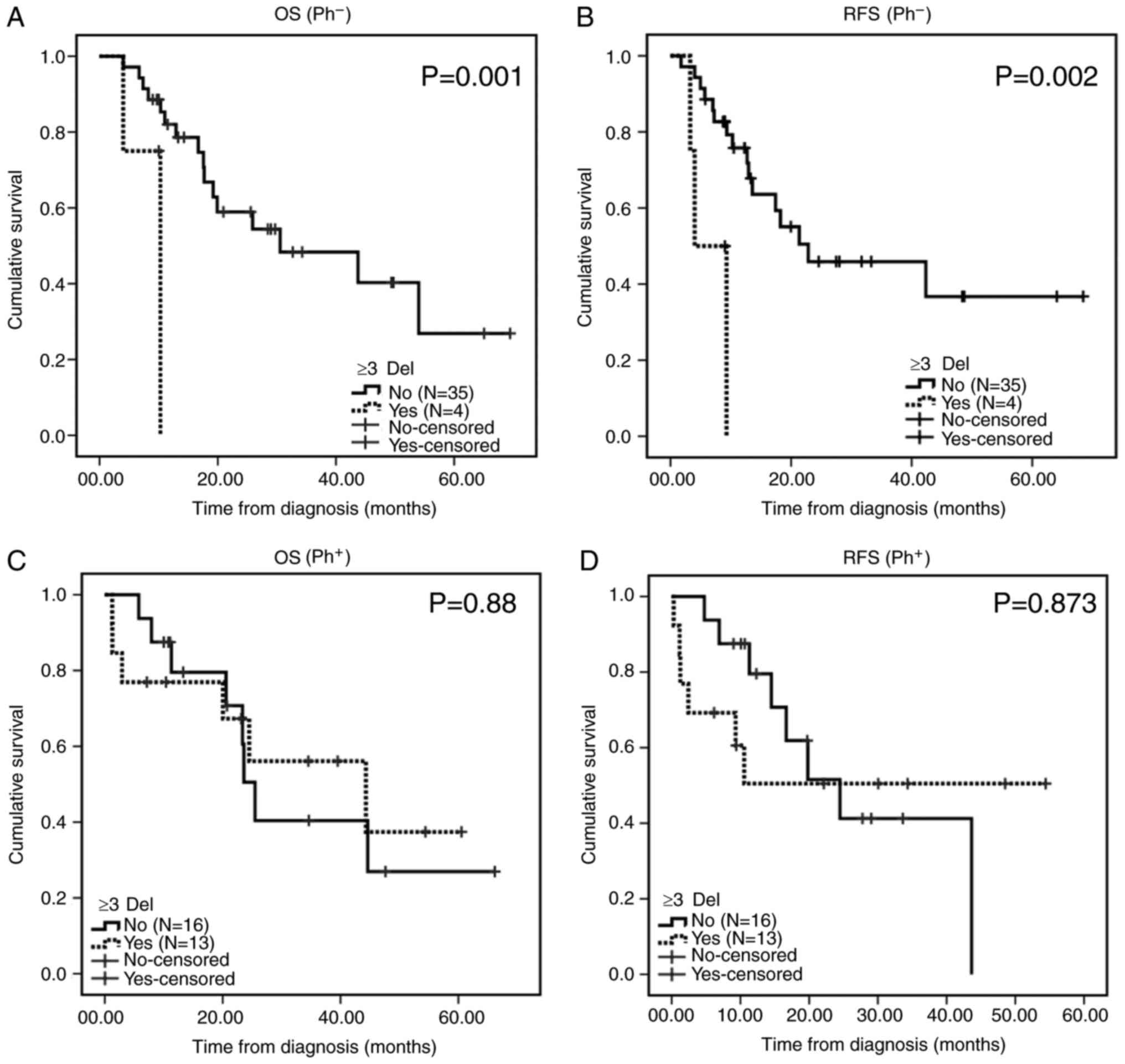Prognostic significance of copy number alterations detected by multi‑link probe amplification of multiple genes in adult acute lymphoblastic leukemia
- Authors:
- Published online on: February 7, 2018 https://doi.org/10.3892/ol.2018.7985
- Pages: 5359-5367
Abstract
Introduction
Acute lymphoblastic leukemia (ALL) is the most common type of leukemia in children, with a low morbidity in adults (1). The efficacy of treatment is significantly increased by optimization of chemotherapy, improved treatment conditions and risk stratification (2). Factors, including age, white blood cell count, genetic characteristics and treatment response, determine the prognosis of adults with ALL (3). The genetic characteristics encompass genomic mutations and gene variations, and genomic analysis proposes a novel perspective on the pathogenesis and prognosis of ALL (4). The association between gene copy number variations (CNVs) and prognosis in adults with ALL has been investigated, but remains inconclusive.
Multi-link probe amplification (MLPA) was initially reported by Schwab et al (5) and Schouten et al (6). This method permits detection of multiple minor CNVs in the human genome and differences in the relative copy number of the target sequences. The method is commonly used to analyze the multiple gene polymorphisms underlying the disease, particularly for the analysis of large samples.
The present study used MLPA to analyze the gene CNVs in 87 adults with ALL treated between July 2009 and March 2015 at the Institute of Hematology and Blood Diseases Hospital (Tianjin, China). The aim of the present study was to determine the association between gene CNVs and the prognosis of a Chinese population of adults with ALL.
Materials and methods
Patients and samples
A total of 87 adult patients with ALL that were diagnosed and treated at the Leukemia department, Institute of Hematology and Blood Diseases Hospital between July 2009 and March 2015 were enrolled in the present study. The inclusion criteria was patients who were diagnosed with ALL aged >14 years. Individuals who had received treatment in other hospitals or were unable to afford regular chemotherapy were excluded. All the patients enrolled in the present study provided written informed consent and the study was approved by Ethics Committee of the Institute of Hematology and Blood Diseases Hospital (Tianjin, China). The diagnosis was based on the morphology, immunophenotype, and molecular and cytogenetic analysis. The median follow-up time was 12.12 months (range, 1.25–63 months) and the rate of loss to follow-up was 5.7% (5/87). The patients were treated with regimens prescribed by ChiCTR-TRC-00000397 as described in Zhao et al (7), Bone marrow (BM) mononuclear cells (MNC) were collected prior to the induction of treatment and a QIAamp DNA Blood Mini kit (cat. no. 51104; Qiagen GmbH, Hilden, Germany) was used for DNA extraction, according to the manufacturer's protocols. TRIzol™ (Life Technologies; Thermo Fisher Scientific, Inc., Waltham, MA, USA) was used to extract RNA, RNA was also extracted from the MNCs of 50 patients (MNCs <106, as dictated by the TRIzol protocol) and was synthesized into cDNA, as previously described (8). Nested reverse transcription polymerase chain reaction (RT-PCR) was performed, as previously described (PCR Master mix; Takara Biotechnology Co., Ltd., Dalian, China) (8).
The present study investigated 87 adults with ALL, including 54 males and 33 females, with a median age of 19 years (range, 14–61 years). Of these patients, 69 presented with B-ALL and 18 with T-ALL. Among the patients with B-ALL, 29 patients exhibited abnormal t(9;22)/BCR-ABL1, which is also described as Ph positive chromosome (Ph+ ALL) and 40 exhibited the Ph negative chromosome (Ph− ALL).
Subgroups included 53 patients in the high-risk group (HR) and 16 in the low-risk group (SR). The T-ALL group included 15 cases of HR and 3 cases of SR. The prognosis was based on the guidelines by Gökbuget and Hoelzer (9). The age of the SR group was ≤35 years and the white blood cell count was <30×109/l; and TEL-AML1, HOX11, NOTCH1, 9p and polyploidy were observed. In contrast, the HR group included patients aged ≥35 years with a white blood cell count of >30×109/l in B-ALL (>100×109/l in T-ALL), diagnosed with pro B-ALL and exhibiting a complex and hypodiploid karyotype. Furthermore, DNA of 10 healthy people were extracted as normal control, including 6 males and 4 females (age range, 22–45 years). The samples from volunteers were collected from January to April 2015 at the Institute of Hematology and Blood Diseases Hospital.
Analysis of copy number alterations (CNAs)
The SALSA MLPA P335 ALL-IKZF1 kit (MRC Holland, Amsterdam, the Netherlands) was applied to detect the gene CNAs, according to the manufacturer's protocol. This kit was able to detect the deletions of IKAROS family zinc finger 1 (IKZF1), purinergic receptor P2Y8 (P2RY8), zinc finger protein, Y-linked (ZFY), Janus kinase 2 (JAK2), paired box 5 (PAX5), ETS variant 6 (ETV6), RB transcriptional corepressor 1 (RB1), BTG anti-proliferation factor 1 (BTG1), early B-cell factor 1 (EBF1), cyclin dependent kinase inhibitor 2A/2B (CDKN2A/2B), cytokine receptor like factor 2 (CRLF2), interleukin 3 receptor subunit α (IL3RA), colony-stimulating factor 2 receptor α subunit (CSF2RA) and short stature homeobox (SHOX) genes. Electrophoresis (pop7 polymer used as supplied) and quantification of fluorescein amidite-labeled amp (4 nmol/ml) icons were performed on an ABI-3730 genetic analyzer (Applied Biosystems; Thermo Fisher Scientific, Inc.), 80°C, 2 min. The resulting peak intensities were normalized to the manufacturer's control probes and the DNA from the normal control was used as a reference.
Statistical analysis
All statistical analyses were performed using SPSS 21.0 software (IBM Corp., Armonk, NY, USA). The data are presented as median ± quartile. Relapse-free survival (RFS; defined as the time between diagnosis and relapse) and overall survival (OS; defined as the time between diagnosis and mortality or last follow-up) were analyzed using the Kaplan-Meier method and the differences between multiple groups were analyzed using the log-rank test. Cox proportional hazards regression models were used to assess the prognostic relevance of different factors. Other comparisons were performed using the X2, Fisher exact, as appropriate. P<0.05 was considered to indicate a statistically significant difference.
Results
MLPA
Analysis of gene deletions
Gene deletions were detected in 58/87 (66.7%) cases of ALL. The common deletions included those in the IKZF1 32.2% (28/87), CDKN2A 35.6% (31/87), CDKN2B 29.9% (26/87), PAX5 18.4% (16/87) and RB1 13.8% (12/87) genes. Deletions in the genes, EBF1 (8/87, 9.2%), BTG1 (8/87, 9.2%) and ETV6 (7/87, 8%), while deletions in the genes, IL3RA-1, JAK2, CSF2RA-1 and P2RY8, accounted for <5%, and no gene deletions were observed in 29 patients (33.3%; Fig. 1A).
In the B-ALL group, gene deletions were detected in 45/69 patients (65.2%). The commonly deleted genes were IKZF1 (28/69, 40.6%), CDKN2A (22/69, 31.9%), CDKN2B (20/69, 29%), PAX5 (15/69, 21.7%), RB1 (10/69, 14.5%), BTG1 (7/69, 10.1%), EBF1 (8/69, 9.2%) and ETV6 (7/69, 8%). No gene deletions were observed in 24 patients (34.8%; Fig. 1B). Among those with gene deletions, one single gene deletion was observed in 16 patients (16/45, 35.6%), two were observed in 11 patients (11/45, 24.4%) and ≥3 were observed in 18 patients (18/45, 40%). The loss of CDKN2A and/or CDKN2B (CDKN2A/2B) was reported in 25 patients (25/45, 55.6%). The loss of IKZF1 and CDKN2A/2B was observed in 11 patients (11/45, 22.4%). Simultaneous deletions of IKZF1 and other genes were reported in 23 patients (23/28, 82.1%). A total of 14 (14/15, 93.3%) cases of PAX5 deletions and 16 (17/25, 64%) of CDKN2A/2B deletions were accompanied by the deletion of other genes. All patients with BTG1 and RB1 deletions exhibited deletions in other genes. At the end of the follow-up period, 22 cases of recurrence were observed in patients with B-ALL. Of these, 15 exhibited gene deletions, including 9 (9/28, 32.1%) with the loss of IKZF1, 9 (9/25, 36%) with the loss of CDKN2A/2B and 5 (5/15, 33.3%) with the deletion of ≥3 genes.
Of the patients with T-ALL, 13/18 (72.2%) harbored the following deletions: CDKN2A (9/18, 50%), CDKN2B (6/18, 33.3%), ETV6 (4/18, 22.2%), RB1 (2/18, 11.1%), EBF1 (2/18, 11.1%), PAX5 (1/18, 5.6%) and BTG1 (1/18, 5.6%; Fig. 1B). Of the 13 patients with gene deletions, 8 (8/18, 44.4%) exhibited 1 gene deletion, 4 (4/18, 22.2%) exhibited 2 and 1 (1/18, 5.6%) exhibited ≥3. Three cases (3/18, 16.7%) were identified with the co-deletion of CDKN2A/2B and other genes. Two (2/18, 11.1%) patients with ETV6 deletions exhibited concurrent deletions of other genes. All the T-ALL patients with BTG1 and RB1 deletions also exhibited other deletions, as observed in the patients with B-ALL. A total of 15 cases of T-ALL displayed recurrence, including 11 patients with gene deletions, of which 6 (6/9, 66.7%) exhibited CDKN2A/2B deletion.
IKZF1 gene deletion analysis
IKZF1 gene deletion was identified in 28/87 patients (32.2%). The IKZF1 gene deletion is significantly more common in Ph+ patients compared with Ph− B-ALL patients (21/29, 72.4% vs. 7/40, 17.5%; P<0.01). The patients in the HR group exhibited a deletion of the IKZF1 gene more frequently than those in the SR group (27/53, 50.9% vs. 1/16, 6.3%. P=0.001). The deletion of CDKN2A/2B and IKZF1 together in patients with Ph+ B-ALL was more frequently observed than in those with Ph− B-ALL (9/29, 31% vs. 3/40, 7.5%; P=0.021). The frequencies of CDKN2A/2B and IKZF1 deletions were higher in the HR group than in the SR group (20.8 vs. 0%; P=0.056; Table I).
Table I.Frequencies of gene deletions in different groups of B-cell acute lymphoblastic leukemia patients. |
A total of 12 cases (12/28, 42.9%) revealed the deletion of exons 4–7, which were the most common deletions, and deletions of exons 1–8 were observed in 2 cases (2/28, 7.1%). Only single cases exhibited a deletion of exons 1 or 6.
A total of 50 cases, including 38 cases of B-ALL and 12 cases of T-ALL, were analyzed by nested RT-PCR for IKZF1 deletion. A total of 32 patients with IKZF1 deletion (64%; 20 patients with IK6 subtype), including 28 patients with B-ALL (73.7%; 16 patients with Ph+) and 4 patients with T-ALL (33.3%), were evaluated by PCR. However, MLPA indicated that only 16/38 patients with B-ALL exhibited the deletion of IKZF1 (8 cases of IK6 subtype), while none of the 12 patients with T-ALL presented with an IKZF1 deletion. Therefore, the sensitivity of the two methods was different.
Analysis of other gene deletions
RB1 deletions in the Ph+ group of patients with B-ALL were more frequent than in the Ph− group (8/29, 31% vs. 1/40, 2.5%; P=0.001). However, single-gene defects in RB1 were not observed. More than three gene deletions were commonly observed in the Ph+ group of patients with B-ALL compared with the Ph− group (13/29, 44.8% vs. 5/40, 12.5%; P=0.004). This phenomenon was more common in the SR group than in the HR group (16/53, 30.2% vs. 2/16, 12.5%; P=0.003). Furthermore, no significant differences were observed in the distribution of other gene deletions across different groups.
Analysis of gene amplification
Amplification of 12 genes was detected in 15 patients (15/87, 17.2%). The common amplifications were noted for SHOX-AREA (3/15, 20%), BTG1 (3/15, 20%) and EBF1 (3/15, 20%) genes. A total of 4/15 patients harbored only the gene amplification and the remaining 11 patients displayed concurrent gene deletions. A single gene amplification was reported in 12 cases and >2 amplifications were observed in 3 patients. The gene amplifications were identified in 14/15 cases of B-ALL, 1 case of T-ALL, 1 case in the SR group and 14 cases in the HR group (6.25 vs. 26.4%). The specific gene amplifications are presented in Fig. 1C.
Effects of gene deletion on survival
Prognostic significance of IKZF1 deletion
In B-ALL, the 2-year OS and RFS rates in patients with IKZF1 deletions were slightly worse than in those without, although no significant difference was observed (OS, 60.8 vs. 51.2%, P=0.247; RFS, 51.3 vs. 35.5%, P=0.169). Furthermore, no significant differences in the 2-year OS (57.5 vs. 47.6%; P=0.256) and RFS (55.6 vs. 34.3%; P=0.209) rates were observed between patients with IKZF1 deletion and those without in the Ph− B-ALL group. Additionally, no significant differences in the 2-year OS (50 vs. 52%, P=0.284) and RFS (50 vs. 42.4%, P=0.256) rates were observed between the 21 patients with IKZF1 deletion and those without in the Ph+ B-ALL group.
Prognostic analysis of gene deletions
Among the patients with B-ALL, the 2-year OS (61.8 vs. 30.2%; P=0.055) and RFS (53.3 vs. 29.3%; P=0.054) rates in patients with CDKN2A/2B deletions were slightly worse than in those without these deletions (Fig. 2). In addition, no significant differences in the 2-year OS (55.2 vs. 34.7%; P=0.296) and RFS (51.7 vs. 31.2%; P=0.275) rates were observed between patients with and without the CDKN2A/2B deletions in the Ph− B-ALL group. The 2-year OS and RFS rates in patients with CDKN2A/2B deletions were worse than in the other patients (60.6 vs. 18.7%, P=0.045) and (63.2 vs. 31.1%, P=0.071) in the Ph+ B-ALL group (Fig. 3). No significant differences were observed in the 2-year OS (72.2 vs. 50%; P=0.544) and RFS (70.7 vs. 50%; P=0.726) rates of patients with CDKN2A/2B deletion in the SR group. The HR group carrying the CDKN2A/2B deletion exhibited poor 2-year OS (58.4 vs. 24.7%, P=0.037) and RFS (50.7 vs. 25%, P=0.047) rates compared with the other patients (Fig. 4).
Prognostic analysis of PAX5 deletion
In the present study, 16 patients carried the PAX5 gene deletion. Among the patients with B-ALL, no significant difference in the 2-year OS (76.7 vs. 54%; P=0.432) and RFS (54.3 vs. 45%; P=0.44) rates was observed between those with and without PAX5 deletions. The Ph− B-ALL patients with PAX5 deletions exhibited poor 2-year OS (90.1 vs. 19%; P=0.004) and RFS (83.7 vs. 21.4%; P=0.016) rates compared with those without this deletion. No significant difference was observed in the OS (59.1 vs. 53.6%; P=0.749) and RFS (63.7 vs. 57.1%; P=0.785) rates of Ph+ B-ALL patients with PAX5 deletion with respect to those in the Ph+ B-ALL group (Fig. 5).
Prognosis of patients with ≥3 gene deletions
No notable differences were observed in the 2-year OS (56.7 vs. 49.4%; P=0.738) and RFS (60.1 vs. 49.7%; P=0.455) rates of B-ALL patients with ≥3 gene deletions (18 cases) compared with the B-ALL patients who harbored <3 gene deletions. Patients with ≥3 gene deletions exhibited poor 2-year OS (0 vs. 85.3%; P=0.001) and RFS (0 vs. 79.2%; P=0.002) rates compared with those in the Ph− B-ALL group. No marked differences were observed in the 2-year OS (50.5 vs. 56.1%, P=0.88) and RFS (61.5 vs. 50.5%, P=0.873) rates of patients carrying ≥3 gene deletions compared with those in the Ph+ group (Fig. 6).
Multifactor analysis of Cox multiple regression
The OS and RFS rates of different patient groups were analyzed using Cox regression based upon multiple factors. The white blood cell count for OS and RFS demonstrated independent prognostic significance in patients with B-ALL [P=0.056 and hazard ratio (HR)=1.004, and P=0.011 and HR=1.005, respectively]. In the Ph− group of patients with B-ALL, the white blood cell count (OS, P=0.003, HR=1.007; RFS, P=0.001, HR=1.007) and ≥3 gene deletions were independent prognostic factors (OS, P=0.007, HR=12.4; RFS, P=0.06, HR=10.301). The CDKN2A/2B gene deletions (OS, P=0.056, HR=3.0) demonstrated independent prognostic significance in the Ph+ B-ALL group. The white blood cell count (RFS, P=0.004, HR=1.005) and CDKN2A/2B gene deletions (OS, P=0.059, HR=2.322) demonstrated independent prognostic significance in the HR group. The PAX5 gene deletion (OS, P=0.049, HR=2.322; RFS, P=0.056, HR=104.7) demonstrated independent prognostic significance in the SR group of patients with B-ALL.
Due to the limited number of T-ALL patients, and limited number of patients exhibiting gene amplification, no significant differences were observed in the survival analysis between different groups.
Discussion
MLPA was used previously to detect the ALL gene copy number in children (10), which revealed that the commonly deleted genes included CDKN2A/B (41%), PAX5 (35%), ETV6 (26%), RB1 (5.1%), BTG1 (4.3%) and EBF1 (1.7%). The IKZF1 deletions accounted for 16, and 26% of the patients with IKZF1 deletions were categorized as the IK6 subtype (4–7 exons deletion). A similar method of detection was observed in 1,644 cases among British children with ALL in 2014 (11). CDKN2A/2B and ETV6 are the commonly (20–25%) deleted genes in children with ALL; and IKZF1 and PAX5 gene deletions occurred simultaneously in 15% of patients. The proportion of other gene deletions was <10%. In ~43% patients, no gene deletions were detected and patients with ≥3 types of gene deletions were observed in 10% of all patients. MLPA facilitated the screening of 204 children with ALL relapse (12). The common gene deletions included CDKN2B (37.7%), CDKN2A (37.3%), IKZF1 (33.3%), PAX5 (26.5%) and ETV6 (25%). The proportion of IKZF1 gene deletions in these cases of ALL relapse was ~2-fold that reported previously in children newly diagnosed with ALL (33 vs. 14–19%). The common gene deletions identified in 142 cases of adolescent and adult ALL were CDKN2A/2B (42%), IKZF1 (35%), PAX5 (34%), RB1 (15%), BTG1 (10%), EBF1 (11%) and ETV6 (7%) (12). The majority of the patients with IKZF1 and CDKN2A/2B deletions also harbored other deletions. The proportion of IKZF1 deletions in Ph+ patients was higher, and the age and white blood cell count of patients with IKZF1 deletion were significantly higher than that of those without this deletion.
The results of the present study demonstrated that 58/87 (66.7%) patients with ALL harbored a gene deletion. The genes that were frequently deleted included IKZF1 (40.6%), CDKN2A (31.9%), CDKN2B (29%), PAX5 (21.7%), RB1 (14.5%), BTG1 (10.1%), EBF1 (9.2%) and ETV6 (7/69, 8%). The 24 patients without gene deletions comprised 34.8% of the cohort. A total of 25 patients (55.6%) carried deletions in CDKN2B and/or CDKN2A genes. A concurrent deletion of IKZF1 and CDKN2A/2B genes was observed in 11 patients (22.4%). Furthermore, in 16 patients (35.6%), only 1 gene was deleted, while 11 (24.4%) patients carried two gene deletions. More than 3 types of gene deletion were detected in a total of 18 cases (40%). Concurrent mutations, including 82.1% with a deletion of IKZF1 and other genes, and 93.3% with a deletion of PAX5 and other genes, were detected. In addition, IKZF1 gene deletions were more common in the Ph+ group of patients with B-ALL than in the Ph− group (72.4% vs. 17.5%), and were more frequent in the HR group than in the SR group (50.9% vs. 6.3%), which was in agreement with previous international adolescent and adult ALL studies (13). A total of 42.9% (12/28) patients with IKZF1 deletions exhibited the IK6 subtype, a ratio that was higher than that reported in previous studies regarding pediatric ALL (14).
As demonstrated in Table II, the gene CNVs differed between adults and children with ALL. The ratio of ETV6 deletions in children with ALL was higher, and the ratios of IKZF1, CDKN2A/2B and EBF1 gene deletions were significantly lower than those in the adults. The prevalence of multiple gene deletions was lower in children than in adults. In the present study, IKZF1 gene deletions were predominant, followed by CDKN2A/2B deletions. Ribera et al (15) reported that German adolescents and adult patients with ALL exhibited prevalent deletions of CDKN2A/2B.
Ofverholm et al (10) revealed that deletion of the IKZF1 gene in childhood ALL was associated with poor OS and event-free survival (EFS) while no significant differences in OS and EFS were observed in children with CDKN2A/2B deficiency. Moorman et al (11) combined the incidence of CNA with risk stratification and revealed that the deletion ratios of CDKN2A/2B, PAX5 and IKZF1 in patients with a poor OS and EFS accounted for 70, 45 and 45%, respectively. The proportion of patients with a better prognosis was 1, 5, and 0%, respectively. Ribera et al (15) reported that the 5-year cumulative incidence rate (CIR) was higher and that the OS was poorer in patients with IKZF1 deletion than in those without the deletion. Additionally, CDKN2A/2B deficiency in patients with B-ALL was associated with a poor OS. The OS of patients with B-ALL, particularly those with Ph− ALL carrying ≥3 gene deletions was poor with an increased CIR. Adult Ph+ ALL patients carrying CDKN2A/2B deletions also exhibited a poor disease-free survival (DFS) (16). The present study evaluated the 2-year OS and RFS in different groups of patients. The deletions of CDKN2A/2B in B-ALL patients were associated with a poorer prognosis compared with that of other patients without CDKN2A/2B deletions. Patients with CDKN2A/2B deletions and those with concurrent IKZF1 and CDKN2A/2B deletions exhibited a poorer prognosis than the patients in the Ph+ ALL group. Compared with the patients without PAX5 deletions, those with PAX5 deletions exhibited a poorer prognosis in the SR group of patients with B-ALL and those with CDKN2A/2B deletion exhibited a poorer prognosis in the HR group of B-ALL patients than patients who did not harbor CDKN2A/2B deletion. Patients with PAX5 deletions and ≥3 gene deletions exhibited a poorer prognosis than the patients in the Ph− group. As mentioned earlier, patients with IKZF1 gene deletions did not exhibit a poor prognosis in the present study, which may be attributed to the small sample size and short follow-up duration. In addition, it was revealed that MLPA was less sensitive than PCR in analyzing the IKZF1 gene deletions, which may result in an increased number of false negative cases and may influence the prognostic significance of such observations (8).
To conclude, 66.7% of adult patients with ALL in a Chinese population exhibited variations in gene copy number. The types and proportions of gene variation were consistent with the results reported in the literature for adult ALL and it was concluded that certain gene copy number variations may be used to predict the prognosis of ALL.
Acknowledgements
The authors would like to thank the Department of Leukemia, Institute of Hematology and Blood Diseases Hospital, Chinese Academy of Medical Sciences and Peking Union Medical College for providing patient samples and the State Key Laboratory of Experimental Hematology for technical assistance. The present study was supported by the National Science and Technology Pillar Program (grant no. 2014BAI09B12), the Tianjin Major Research Program of Application Foundation and Advanced Technology (grant no. 15JCZDJC36400) and the Science and Technology Project of Tianjin (grant no. 15ZXLCSY00010).
Competing interests
The authors declare that they have no competing interests.
References
|
Mullighan CG, Goorha S, Radtke I, Miller CB, Coustan-Smith E, Dalton JD, Girtman K, Mathew S, Ma J, Pounds SB, et al: Genome-wide analysis of genetic alterations in acute lymphoblastic leukaemia. Nature. 446:758–764. 2007. View Article : Google Scholar : PubMed/NCBI | |
|
Kuiper RP, Schoenmakers EF, van Reijmersdal SV, Hehir-Kwa JY, van Kessel AG, van Leeuwen FN and Hoogerbrugge PM: High-resolution genomic profiling of childhood ALL reveals novel recurrent genetic lesions affecting pathways involved in lymphocyte differentiation and cell cycle progression. Leukemia. 21:1258–1266. 2007. View Article : Google Scholar : PubMed/NCBI | |
|
Harvey RC, Mullighan CG, Wang X, Dobbin KK, Davidson GS, Bedrick EJ, Chen IM, Atlas SR, Kang H, Ar K, et al: Identification of novel cluster groups in pediatric high-risk B-precursor acute lymphoblastic leukemia with gene expression profiling: Correlation with genome-wide DNA copy number alterations, clinical characteristics, and outcome. Blood. 116:4874–4884. 2010. View Article : Google Scholar : PubMed/NCBI | |
|
Roberts KG and Mullighan CG: Genomics in acute lymphoblastic leukaemia: Insights and treatment implications. Nat Rev Clin Oncol. 12:344–357. 2015. View Article : Google Scholar : PubMed/NCBI | |
|
Schwab CJ, Jones LR, Morrison H, Ryan SL, Yigittop H, Schouten JP and Harrison CJ: Evaluation of multiplex ligation-dependent probe amplification as a method for the detection of copy number abnormalities in B-cell precursor acute lymphoblastic leukemia. Genes Chromosomes Cancer. 49:1104–1113. 2010. View Article : Google Scholar : PubMed/NCBI | |
|
Schouten JP, McElgunn CJ, Waaijer R, Zwijnenburg D, Diepvens F and Pals G: Relative quantification of 40 nucleic acid sequences by multiplex ligation-dependent probe amplification. Nucleic Acids Res. 30:e572002. View Article : Google Scholar : PubMed/NCBI | |
|
Zhao X, Wie H, Lin D, Wang Y, Zhou C, Liu B, Li W, Liu K, Wang H, Li C, et al: Optimal treatment of adult Ph negative acute lymphoblastic leukemia. Zhonghua Xue Ye Xue Za Zhi. 35:873–879. 2014.(In Chinese). PubMed/NCBI | |
|
Fang Q, Zhao X, Li Q, Li Y, Liu K, Tang K, Wang Y, Liu B, Wang M, Xing H, et al: IKZF1 alterations and expressions of CRLF2 predict prognosis in Chinese adult patients with B-cell precursor acute lymphoblastic leukemia. Leuk Lymphoma. 58:127–137. 2017. View Article : Google Scholar : PubMed/NCBI | |
|
Gökbuget N and Hoelzer D: Treatment of adult acute lymphoblastic leukemia. Semin Hematol. 46:64–75. 2009. View Article : Google Scholar : PubMed/NCBI | |
|
Ofverholm I, Tran AN, Heyman M, Zachariadis V, Nordenskjöld M, Nordgren A and Barbany G: Impact of IKZF1 deletions and PAX5 amplifications in pediatric B-cell precursor ALL treated according to NOPHO protocols. Leukemia. 27:1936–1939. 2013. View Article : Google Scholar : PubMed/NCBI | |
|
Moorman AV, Enshaei A, Schwab C, Wade R, Chilton L, Elliott A, Richardson S, Hancock J, Kinsey SE, Mitchell CD, et al: A novel integrated cytogenetic and genomic classification refines risk stratification in pediatric acute lymphoblastic leukemia. Blood. 124:1434–1444. 2014. View Article : Google Scholar : PubMed/NCBI | |
|
Krentz S, Hof J, Mendioroz A, Vaggopoulou R, Dörge P, Lottaz C, Engelmann JC, Groeneveld TW, Körner G, Seeger K, et al: Prognostic value of genetic alterations in children with first bone marrow relapse of childhood B-cell precursor acute lymphoblastic leukemia. Leukemia. 27:295–304. 2013. View Article : Google Scholar : PubMed/NCBI | |
|
Yuan T, Zhao XL, Zhang LX, Li QH, Tian Z, Tang KJ, Wang Y, Lin D, Li W, Liu BC, et al: Expression and clinical significance of IKZF1 gene IK6 isoforms in adult acute lymphoblastic leukemia. Zhongguo Shi Yan Xue Ye Xue Za Zhi. 21:539–543. 2013.(In Chinese). PubMed/NCBI | |
|
Yamashita Y, Shimada A, Yamada T, Yamaji K, Hori T, Tsurusawa M, Watanabe A, Kikuta A, Asami K, Saito AM and Horibe K: IKZF1 and CRLF2 gene alterations correlate with poor prognosis in Japanese BCR-ABL1-negative high-risk B-cell precursor acute lymphoblastic leukemia. Pediatr Blood Cancer. 60:1587–1592. 2013. View Article : Google Scholar : PubMed/NCBI | |
|
Ribera J, Morgades M, Zamora L, Montesinos P, Gómez-Seguí I, Pratcorona M, Sarrà J, Guàrdia R, Nomdedeu J, Tormo M, et al: Prognostic significance of copy number alterations in adolescent and adult patients with precursor B acute lymphoblastic leukemia enrolled in PETHEMA protocols. Cancer. 121:3809–3817. 2015. View Article : Google Scholar : PubMed/NCBI | |
|
Iacobucci I, Ferrari A, Lonetti A, Papayannidis C, Paoloni F, Trino S, Storlazzi CT, Ottaviani E, Cattina F, Impera L, et al: CDKN2A/B alterations impair prognosis in adult BCR-ABL1-positive acute lymphoblastic leukemia patients. Clin Cancer Res. 17:7413–7423. 2011. View Article : Google Scholar : PubMed/NCBI |



